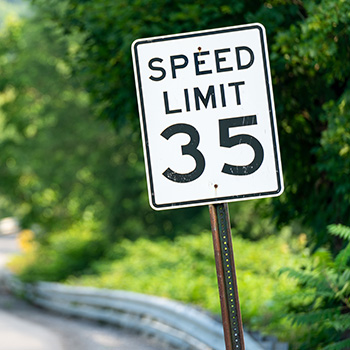The History of Speed Limits in America: A Nation Speeding Up

Whether you appreciate them or hate them, speed limits are an important part of American history. Here’s a brief history about speed limits and how they’ve evolved across the country over time.
Early Speed Limit Laws
Connecticut was the first state to pass a speed limit law back in 1901.This law limited the legal speed of motor vehicles to 12 mph in cities and 15 mph on country roads. However, there were laws even before this that limited the speed of non-motorized vehicles.
According to The History Channel, the colony of New Amsterdam (now New York) issued a law in 1652 stating that wagons, carts and sleighs cannot be run, rode or driven at a gallop. Violators faced a penalty that started at two pounds Flemish , which is about $150 by today’s standards. And in 1903, New York City introduced America’s first comprehensive traffic code.
The National Limit of 55 mph
The cost of rising fuel prices caused many states to start adopting speed limit laws to save money and resources in the early 1970s. President Richard Nixon agreed to a national speed limit of 55 mph for all states in 1974. After this law went into effect, America saw its traffic fatality rate drop from 4.28 per million miles traveled in 1972 to 2.73 in 1983.
However, the availability of fuel and the cost of fuel became less of an issue in the 1980s, and the national maximum speed limit on interstates was increased to 65 mph.
Freedom v. Regulation
Since the days of the early automobile, there has been a debate about the freedom versus regulation in regards to speed limits. Some states, such as Montana and Nevada, have historically opposed restrictive speed limit laws and imposed minimal fines for noncompliance.
In 1995, the U.S. Congress handed speed limit laws back over to the individual states and allowed each state to decide its maximum speed to drive. Since then, 35 states increased their limits to 70 mph or higher.
Speed Limits Today
The fastest road in America is a 40-mile stretch of a toll road between Austin and San Antonio that legally allows drivers to travel at 85 mph. Speed limits have shifted across America as cars have become faster and roads have become safer. Today, speed limits are complex, state-specific, and bound by law. The enforcement of speed limits and the politics that surrounds that enforcement are equally complex.
“People want to go fast,” says Adrian Lund, President of the Insurance Institute for Highway Safety. “Cars are built to go fast and states increasingly want to raise their speed limits. Even if it means saving just two or three minutes during a trip, people want to go faster.”
However, one thing has remained constant throughout the history of speed limits. Disobeying speed limit signs will always result in costly fines and an increased risk of accidents. To learn more about reducing points on your license from speeding ticket fines, check out our New York Online Defensive Driving Course and our other state-approved traffic school courses.
